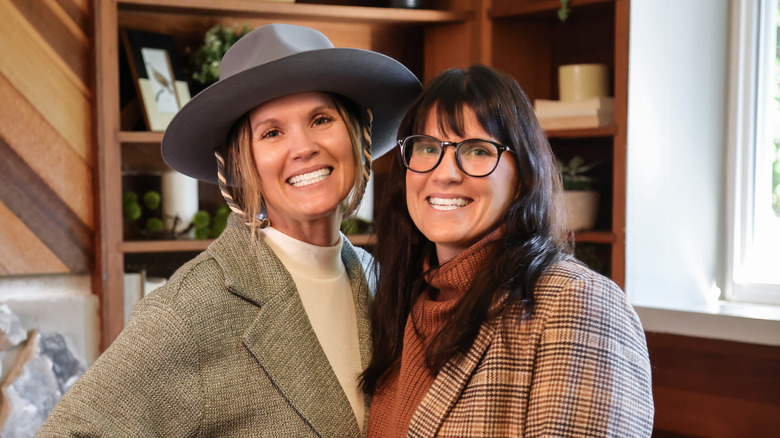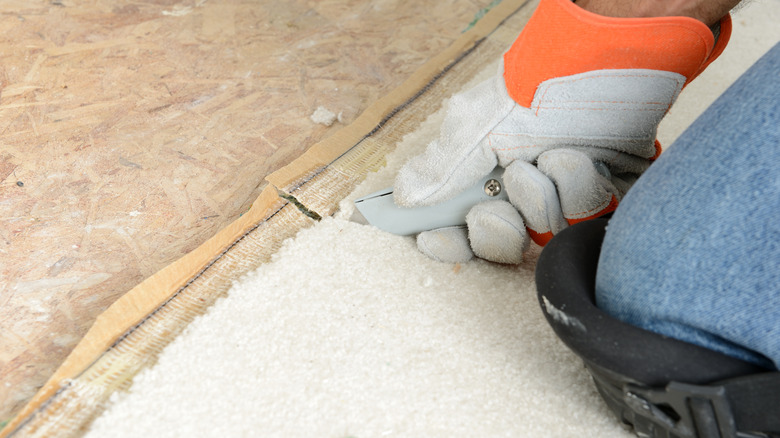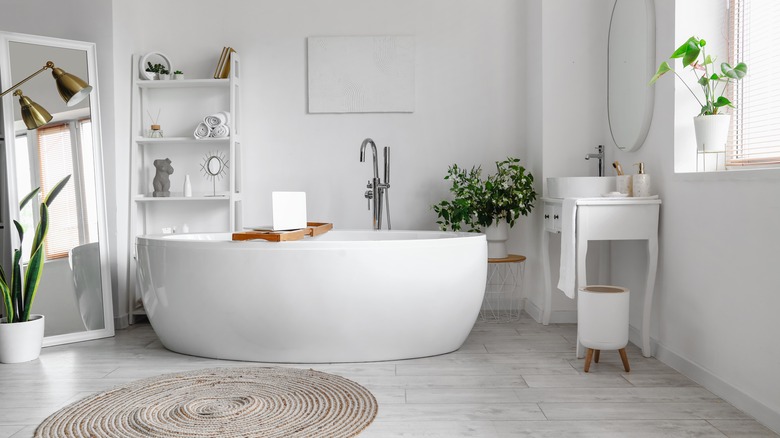The Dated Bathroom Flooring The Stars Of Unsellable Houses Recommend Replacing
There's vintage, and then there is just outdated. Having features in your home that could easily slot into a bygone decade might not always land in the "vintage" category, and some trends just have to go. The stars of "Unsellable Houses" are very familiar with home decor and interior designs that just aren't producing an appealing (or practical) aesthetic, and they agree that carpet in the bathroom is one of these no-nos. While soft flooring feels great, especially in bare feet, keeping carpet in and around your washroom fixtures can create major drawbacks for the entire space. These include mildew and bacteria, along with a dated look that might be holding your home back.
If your home is older, chances are there might be carpet throughout the structure. Back in the '50s, carpet was just coming into play as a relatively affordable home feature. Many homes incorporated it and used it everywhere, including the bathrooms. Thoughts of mold spores weren't important then, because for decades after, this cost-effective option provided comfort as well as safety due to the non-slip elements. However, now people are more aware of the cons of using carpet in moist areas, and the "Unsellable Houses" team agree that these soft fittings need to go ... at least when it comes to the bathroom.
Carpet is a breeding ground for bacteria
So, if your bathroom features carpet, what should you do? The simple answer is to replace it. The stars of "Unsellable Houses" noted in one interview that '80s homes usually feature wall-to-wall carpet in the bathrooms. Lyndsay Lamb said, "That's very, very common. So that ... always has to change," (via House Beautiful). If you really want to get into the yuck factor, carpets host an elevated amount of dust compared to other floor types, and when that dust comes into contact with moisture, fungi ensues. No matter how open or how much air flow your bathroom receives, whenever water comes into contact with the fibers, they can absorb it and grow bacteria. Over time, this accumulates and spreads into mold or mildew, which can exacerbate asthma and allergy symptoms and affect the integrity of the carpeting.
There are things you need to know before ripping up your carpeting, including what to do with your old carpet when you're ready to get rid of it. There might be a lot of it depending on the size of your bathroom. Keep an exit strategy ready so you're not stuck with a bunch of old material. It's a big job, but the end result will be worth it when you don't have to worry about mold or bacteria lurking inside the fibers, and you will bring your bathroom into the modern century, which is something the stars of "Unsellable Houses" would certainly condone.
Try these flooring options instead
In place of carpet, luxury vinyl and vinyl roll also work well in bathrooms thanks to their ability to repel water and moisture. They are durable and cost-effective and can last up to 20 years. The cost ranges between $800 and $1,800 depending on if you opt for sheets, tiles, planks, and luxury options. Great for anyone working on a budget, these low-maintenance floors will transform your bathroom without breaking the bank. It helps that these can be DIYed, too, which saves on labor.
Choosing a replacement flooring doesn't have to be stressful or confusing. There are a variety of options to suit any budget and preference. The stars of "Unsellable Houses" can't stop using one type of flooring in their bathrooms, and it's great if mold and bacteria are concerns. Ceramic tiles are known for their antimicrobial properties, and the material can deflect water, so it doesn't absorb in large amounts and create icky build-up or mildew. It costs anywhere from $8 to over $40 to install per square foot but is also easy to clean and is one of the most lasting materials you can choose. Porcelain is another good option, so the big piece to consider when deciding between porcelain vs. ceramic tiles is the different ingredients used to make each, which is what differentiates them.


